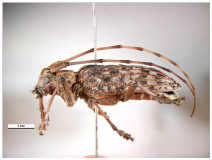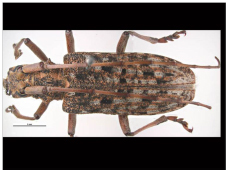 Japanese sawyer beetle, also known as Japanese pine sawyer, is one of a number of pine-infesting
Monochamus longhorn beetles that attack stressed or recently killed trees. It is known to attack many species of pine, as well as some species of spruce, fir, cedar and larch.
Japanese sawyer beetle, also known as Japanese pine sawyer, is one of a number of pine-infesting
Monochamus longhorn beetles that attack stressed or recently killed trees. It is known to attack many species of pine, as well as some species of spruce, fir, cedar and larch.
Japanese sawyer beetle is indigenous to Japan, but is also known from China, Taiwan, Korea, Laos and Vietnam.
 Japanese sawyer beetles lay eggs into trees that are already stressed due to damage or disease, or trees which have recently been killed. Infestation of recently felled trees can reduce their value as timber. However, the main concern is that Japanese sawyer beetle, like other
Monochamus species are vectors for the pine wilt nematode (Bursaphelenchus spp.). The ability of Japanese sawyer beetle to move this damaging nematode both by its feeding and egg laying behaviour and to potentially introduce it to new areas is of significant concern.
Japanese sawyer beetles lay eggs into trees that are already stressed due to damage or disease, or trees which have recently been killed. Infestation of recently felled trees can reduce their value as timber. However, the main concern is that Japanese sawyer beetle, like other
Monochamus species are vectors for the pine wilt nematode (Bursaphelenchus spp.). The ability of Japanese sawyer beetle to move this damaging nematode both by its feeding and egg laying behaviour and to potentially introduce it to new areas is of significant concern.
How to identify Japanese sawyer beetle (Monochamus alternatus)
Like other longhorn beetles, Japanese sawyer beetle is characterised by having antennae longer than its body. Adult beetles are about 15 to 30 millimetres long and 4 to 10 millimetres wide. The adult is a mottled orange-brown colour with defined stripes running the length of its body. Larvae are white coloured grubs up to 43 millimetres in length. Eggs are about 4 millimetres long and curved in shape.
After emergence, the Japanese sawyer beetle feeds on foliage and completes its maturation, which may take up to a week for a male and three weeks for a female to lay eggs. The female gnaws a wound in the bark and lays a single egg in each wound. While there are records of adults flying up to 3 kilometres, most adults fly less than 200 metres.
Keep Japanese sawyer beetle (Monochamus alternatus) out of Australia
The beetle is most likely to arrive in imported timber and wood used for pallets and other packing materials from Asia. Other Monochamus beetle species might also be associated with timber from other countries, particularly North America. Look out for larval tunnels in the wood up to 10 millimetres wide, sawdust-like frass falling from damaged timber, and round exit holes about 10 millimetres wide.
